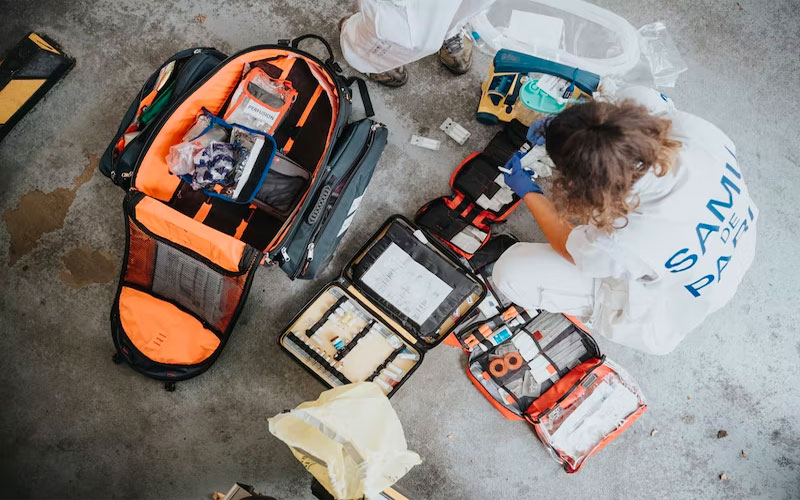Employees are more likely prone to getting injured in the workplace. This is especially true for people working in high-risk industries, such as manufacturing, transportation, mining, and construction. Given the established safety measures at work, accidents resulting in more severe injuries may still happen. Consequently, the victim may have to spend considerable money on medical bills and take some time off work to speed up the recovery. It is important for everyone to know these first-aid tips.
First-Aid Tips

Because of this, employees must undergo first aid training to provide immediate medical attention in case of an accident. Familiarizing yourself with the essential first-aid practices allows you to respond appropriately and quickly to prevent further medical complications and other adverse consequences.
Read on to learn the four first-aid tips and practices you should consider in the workplace.
Remain Calm
When someone has been injured at work, it’s best to keep yourself calm. Sometimes, the severity of the injuries may be aggravated further due to the impulsive actions and decisions of other people in the workplace. So, if you’re at the accident scene, keep calm and don’t panic to allow yourself to make the best judgment about the accident and the injury sustained by a team member.
When you don’t panic, you can better understand the primary goals of first-aid, which include preserving life, preventing further injury, and promoting recovery. If there’s an injured person in the workplace, your goal is to keep them alive and safe while waiting for the medical professionals to arrive. This way, you can keep the injuries from further worsening, thereby causing more severe complications.
When this happens, the injured person can minimize the adverse effects of the accident and injury to their life. They may seek legal help to improve their chances of receiving compensation if they’re qualified. For example, suppose they’ve been injured in one of the common accidents on a construction site. In that case, they may file a workers’ compensation claim with the assistance of a lawyer to help them achieve just compensation. Additionally, understanding the different types of damages in a personal injury case can be beneficial for those seeking compensation.
Assess The Situation
Before helping an injured person in the workplace, it’s essential to evaluate the situation for any possible danger. Doing so can give you peace of mind that you can help the injured without putting yourself in danger.
Removing any potential safety hazards is crucial to assessing the situation before attending to the accident scene. If it’s already safe to approach the injured person, the next step is to identify the cause of the injury. It’s best to prevent them from moving until the medical professionals arrive because it could worsen their situation.
Lastly, make sure to call 911 or the emergency services in your area as quickly as possible. Inform them about what happened so that proper medical assistance will be dispatched to the accident scene.
Administer The First-Aid
While waiting for the emergency services to arrive, it’s best to administer first-aid if you’re trained. To get started, you need to make the injured person feel comfortable. You can remove all surrounding equipment and clear the accident scene of all the bystanders to provide good airflow. If the injured person is conscious and breathing, talk to them to keep them awake and ensure they’re breathing properly until the emergency responders come.
On the other hand, if there’s bleeding, look for a cloth or bandage and apply it to the wound. Make sure to use direct pressure to prevent the person from sustaining severe blood loss. If you see an object stuck on the victim’s body, don’t attempt to remove it, especially if you’re not trained to do so.
When it comes to a head, neck, or back injury, it’s best not to move the injured person unless there’s a danger. Remember that unnecessary movement may worsen the damage and cost the person’s life. So, try to be extra careful in moving them while waiting for the help to arrive.
Always Prepare A Complete First-Aid Kit
When applying basic first aid, preparation is essential. That said, it’s crucial to equip yourself with the right first-aid kit apart from some life-saving skills. If you have the necessary materials, you can cater to whatever injuries you may need to attend to in the workplace. Some first-aid supplies you should prepare include:
- Antiseptic wipes
- Band-aids
- Burn gel
- Gauzes
- Disposable gloves
- Rubbing alcohol
- Painkillers
- Tourniquet
- First-aid manual
There are several first-aid essentials that you should have in the workplace. But besides the ones mentioned, you can include over-the-counter medicines, such as ibuprofen and aspirin, and other items helpful in emergencies like accidents in the workplace.
Conclusion
A simple administration of basic first-aid tips in the workplace can save a life. Employees with first-aid training can help prevent someone else’s injuries from becoming more life-threatening. Hence, it’s best to keep these tips and practices in mind as a team member. Having the proper first-aid knowledge allows you to manage emergencies at work and prevent any harm more effectively.
